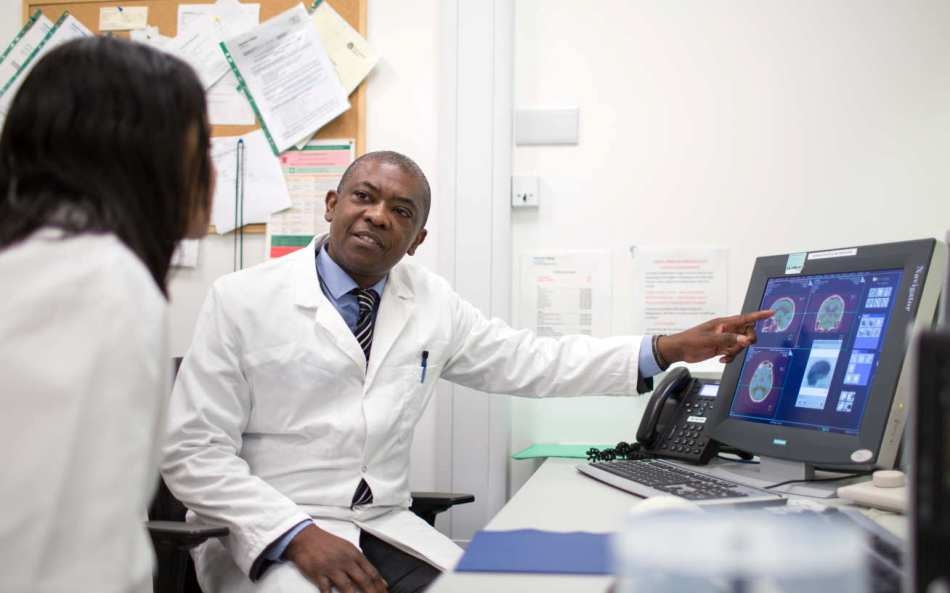Feb 18 2019
A new machine-learning software with the ability to predict the survival rates and response to treatment of patients suffering from ovarian cancer has been developed by researchers at Imperial College London and the University of Melbourne.
 Professor Eric Aboagye, Professor of Cancer Pharmacology and Molecular Imaging at Imperial College London. (Image credit: Imperial College London)
Professor Eric Aboagye, Professor of Cancer Pharmacology and Molecular Imaging at Imperial College London. (Image credit: Imperial College London)
The artificial intelligence software has exhibited the potential forecast the prognosis of patients suffering from ovarian cancer more precisely compared to existing methods. In addition, it can predict the most effective treatment for patients following diagnosis.
The trial, reported in Nature Communications, was carried out at Hammersmith Hospital, part of Imperial College Healthcare NHS Trust.
According to the researchers, this innovative technology could assist clinicians in administering the ideal treatments to patients more rapidly and opens the door for more personalized medicine. They believe that the technology can be applied to differentiate ovarian cancer patients into groups based on the slight differences in the texture of their cancer on CT scans instead of classification based on the type of cancer they have, or the stage of cancer.
The long-term survival rates for patients with advanced ovarian cancer are poor despite the advancements made in cancer treatments. There is an urgent need to find new ways to treat the disease. Our technology is able to give clinicians more detailed and accurate information on the how patients are likely to respond to different treatments, which could enable them to make better and more targeted treatment decisions.
Eric Aboagye, Professor of Cancer Pharmacology and Molecular Imaging, Imperial College London
Aboagye is the lead author of the study.
Artificial intelligence has the potential to transform the way healthcare is delivered and improve patient outcomes. Our software is an example of this and we hope that it can be used as a tool to help clinicians with how to best manage and treat patients with ovarian cancer.
Andrea Rockall, Professor and Honorary Consultant Radiologist, Imperial College Healthcare NHS Trust
Rockall is the co-author of the study.
Ovarian cancer is the sixth most prevalent cancer type in women and generally affects women following the menopause or those who have a family history of the condition. Every year in the United Kingdom, 6000 new cases of ovarian cancer emerge; however, the long-term survival rate is only about 35%–40% since the condition is usually diagnosed at a considerably later stage once symptoms like bloating become noticeable. Survival rates could be improved by early detection of the disease.
Ovarian cancer is diagnosed by doctors in several ways, such as a blood test looking for a substance known as CA125—an indication of cancer—followed by a CT scan in which X-rays and a computer are used to develop detailed images of the ovarian tumor. This assists clinicians in learning the extent to which the disease has spread and determine the mode of treatment patients are administered, such as chemotherapy and surgery.
Yet, the scans cannot offer clinicians a comprehensive understanding of patients’ possible overall outcomes or on the probable effect of a therapeutic intervention.
A mathematical software tool known as TEXLab was used by the researchers to determine the aggressiveness of tumors in CT scans and tissue samples from 364 women suffering from ovarian cancer from 2004 to 2015.
The software investigated four biological properties of the tumors which have a considerable effect on the overall survival— size, structure, shape, and genetic makeup—to evaluate the prognosis of the patients. Then, the patients were given a score called Radiomic Prognostic Vector (RPV), indicating the severity of the disease, ranging from mild to severe.
The results were compared by the researchers with blood tests and current prognostic scores given by doctors to predict the survival. It was found that compared to standard methods, the software was nearly four times more accurate in forecasting deaths from ovarian cancer.
The researchers also found that the survival rate of 5% of patients with high RPV scores was less than two years. High RPV was also related to chemotherapy resistance as well as poor surgical outcomes, indicating that it is possible to use RPV as a potential biomarker to forecast the response of patients to treatments.
According to Professor Aboagye, this technology can be applied to identify patients who are not likely to respond to standard treatments and provide them with alternative treatments.
The researchers will perform a larger study to verify the accuracy of the software in predicting the surgery outcomes and/or drug therapies for individual patients.
The NIHR Imperial Biomedical Research Centre, the Imperial College Experimental Cancer Medicine Centre, and Imperial College Healthcare Tissue Bank funded the research.